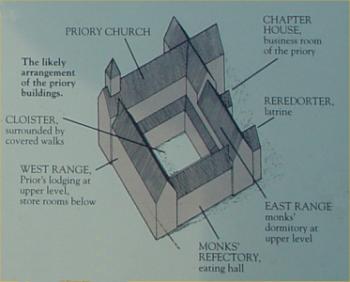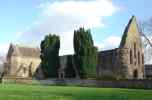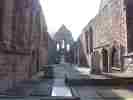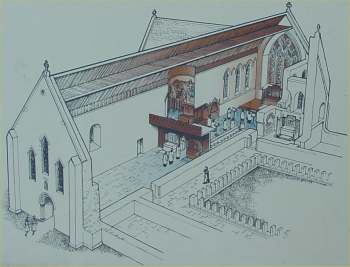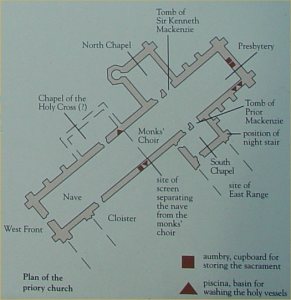|
BEAULY
PRIORY Take a moment to imagine the 'beautiful place' (from the French beau lieu) where monks of the Valliscaulian order came to build their priory around 800 years ago. Close to a series of bends in the river the monks would have found little more here than perhaps a chapel and isolated farmsteads. This was not just a pretty spot but somewhere with good agricultural land and excellent fishing that would be able to support a community of up to 20 monks, as well as the lay brethren who undertook their agricultural work and other duties. Today the ruined church is all that survives the complex of buildings that once stood within the priory precinct. Immediately in front on the south side of the church, a range of two-storey buildings enclosed an open cloister; their stubs can be seen jutting out from the wall. Beyond were orchards, gardens and probably agricultural buildings, stores and accommodation used by the lay brothers. Beauly is
one of only three Valliscaulian foundations known in Britain, all of which
are in the Scottish Highlands. The reformation in 1560 brought about an end to the religious life of the priory. Beauly was unable to maintain itself as an independent house for long and its considerable holdings shortly became private property. While the church remained in use as a burying ground, the other buildings were substantially robbed, not least to build Cromwell's for in Inverness in 1563. the building has been in the care of the State since 1909. Text and drawings Historic Scotland Finding Beauly - Road A862 Map 26 NH 527 464 |
Work on the church began after the priory's foundation in around 1230, once the monks had built their accommodation. It was originally conceived as an elongated rectangle with a chapel or sacristy on the north side. As far as we know the church remained much as it was until the fifteenth century when the records of repairs and additions begin to appear. The Frasers of Lovat, local benefactors built the chapel of the Holy Cross around 1416 and continued to make repairs throughout the century. As with many monastic foundations, Beauly suffered towards the end of the Middle Ages, including being plundered in 1506. A decision was made to abandon the Valliscaulian way of life in favour of the Cistercian order and with this came a brief period of spiritual renaissance.
Robert Reid, the commendator from 1531, was particularly active, building a spacious prior's house and rebuilding the church's west end after a lightning strike in 1541; his coat of arms as Bishop of Orkney can be seen over the west door. Within the church are many tombs and gravestones, including those from families still connected with Beauly today. The splendid tombs of Prior Mackenzie (d. 1479) and Sir Kenneth Mackenzie (d. 1492), his half-brother, can be seen opposite each other in the monk's choir. The North chapel, the burial place of the family, was restored in 1900 by the architect Thomas Ross. We do not know for sure where the monks were buried but in and around the church are the gravestones of the many townsfolk who were buried here in more recent times. The paved floor is modern. |
